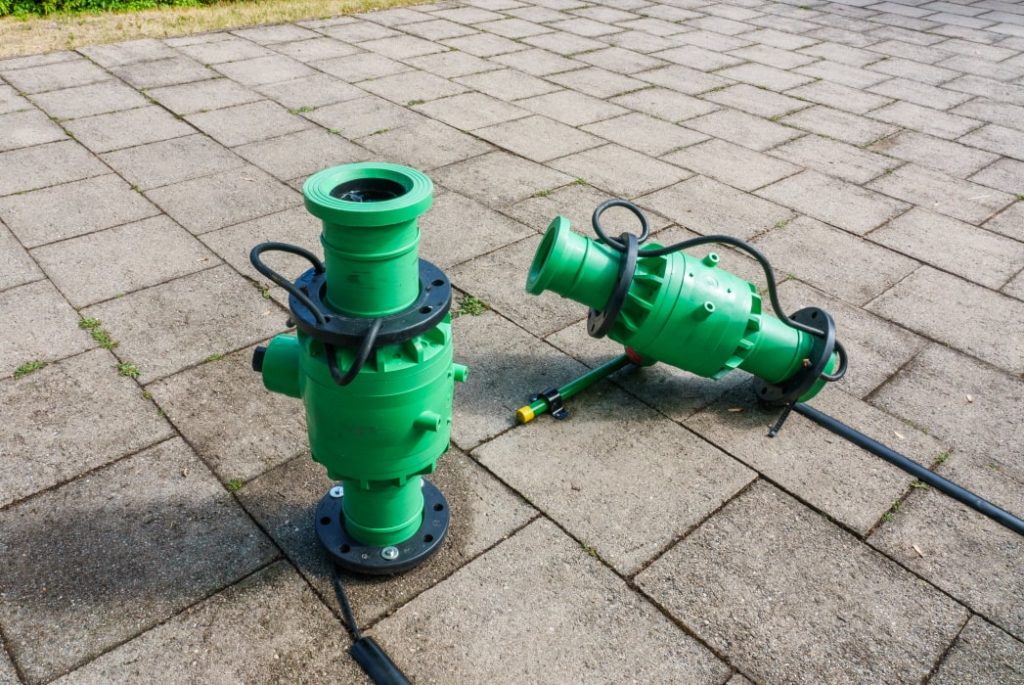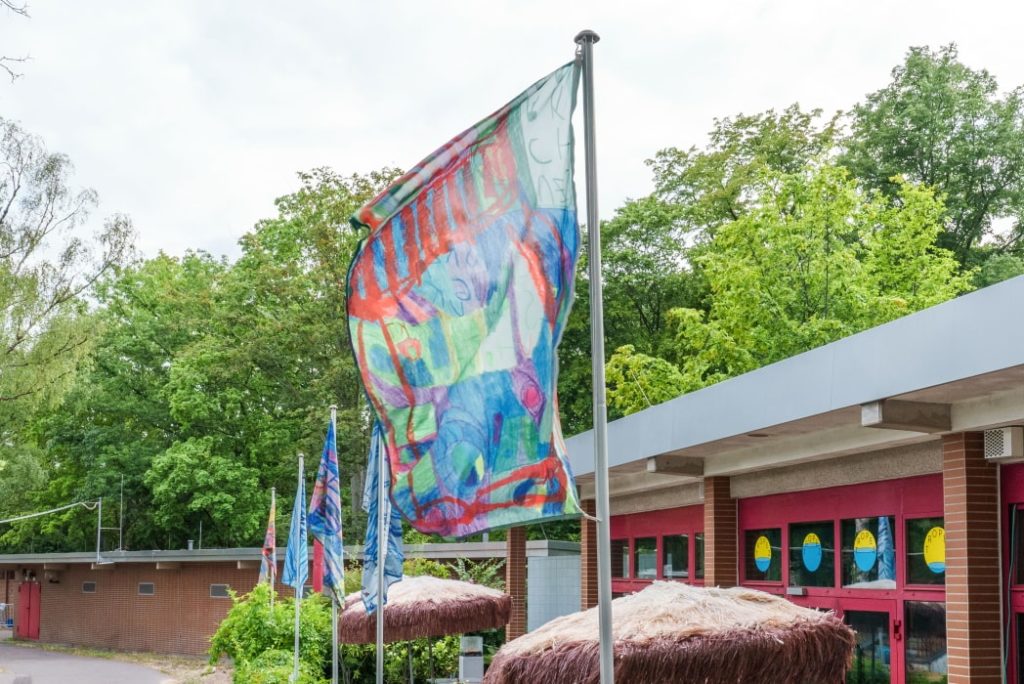On July 7th, TROPEZ, a space for art inside the public pool Sommerbad Humboldthain, opens the group exhibition “…”. The exhibition features seven works by Ana Alenso, Grit Burmeister & Franzi Kleinert, Samira Hodaei, Lungiswa Gqunta, Isa Melsheimer, Nadim Vardag and Shira Wachsmann, which will be installed in the outdoor area of the space. The sculptures and (video-)installations translate the effects of various crises into tangible images and address speechlessness in the face of current world events. The title “…” refers to the three dots that appear on messenger services while the other person is writing and you are waiting for their response. What could we answer?
Image above: TROPEZ © Ink Agop
On the terrace in front of the pool is an installation of finished objects by Ana Alenso. residual dreams comprises a combination of urban, organic and sonic elements. Starting with a sewage pipe, the work questions their invisible presence in our everyday life in the city. What does the object tell us about its origin and use? A small fountain bubbles in a pipe, a loudspeaker plays back water sounds. The interplay of the different components picks up on the tension between the industrial and natural environment of TROPEZ. In her artistic practice, Alenso refers to cyclical, anthropocentric and self-destructive aspects in our relationship with nature.

For the flags in front of the TROPEZ, Grit Burmeister and Franzi Kleinert depicted their perspective on the summer pool. Swimming pool means love, said Grit Burmeister when she heard about the TROPEZ project. She placed her unmistakable images of people with oil pastels on Franzi Kleinert’s extensive coloured pencil canvases. Beings as if from another world look at us with big eyes and their mouths wide open to show their teeth. For Burmeister, to show one’s teeth means to defend oneself against exclusion and incomprehension. With colour fields and letters, Kleinert’s drawings refer to summer.

Behind one of the windows at the kiosk, the video Feet under Fire is playing. It shows Lungiswa Gqunta‘s lower legs swinging in and out of the frame, wearing scrub brushes as shoes. The video is accompanied by voices singing the nursery rhyme Umzi Watsha, which translates from isiXhosa as The House is on Fire. Fascinated by the kneeling, scrubbing actions on the floors, Gqunta exposes the superficiality of urban development as seen in the cosmetic “improvement” of Port Elizabeth’s townships. In the film, a voice calls out: look there, there is a fire, pour water! A survival guide for those living in the confines of South Africa’s settlements: Fires, started by open cooking fires and paraffin stoves, must be extinguished united, thus welding the community together. Gqunta uses the element of fire as a metaphor for change. Gqunta says: Our house, like our whole country, is on fire and who is going to put out the fire? We need to unite to put it out, as Black people. Not only as South Africans, but across the continent.

An installation by Samira Hodaei can be found on a tree in the green area of the summer pool. The tablecloth (sofreh or sufra) is considered a sacred object in Iran; lovingly woven in bright, warm colours and provided with symbols of blessing and hope. Tablecloths were placed on the ground to pray for rain. Since the discovery of oil from the depths of the earth, there has been much debate about oil: blessing or curse? An empty tablecloth was sewn together from empty rice sacks and painted with tar, which was designed with misbaha beads and kalamkari wood prints. The layers symbolise how laboriously oil has integrated itself into people’s daily lives and dining tables.

Next to the TROPEZ it moulds and thrives: Isa Melsheimer has filled three glass boxes with food from the kiosk. The so-called Ward’s boxes, invented by Nathaniel Ward in the 1830s, are airtight systems. This method made plants transportable even over long sea distances and enriched the colonial powers in their plant hunting. The boxes only need light – the water cannot evaporate and oxygen is provided when it greens, through photosynthesis. Composting produces minerals that act as fertiliser. The pedestals pick up on the texture of the swimming pool architecture and thus blend into their surroundings. With her work, Melsheimer proposes a recalibration of human relationships with the environment.

Two works of art by Nadim Vardag are installed to the left and right of the kiosk windows. In his drypoint etchings, like those in the showcase, Vardag concentrates on the motifs of the knot or the fabric. The technique of etching serves Vardag as a means of a pictorial language that deals with the (pictorial and world) ordering functions of grids and structures. With these works, Vardag deepens his examination of how we see, the visible and its representation. Opposite this is an empty folding frame, normally used for advertising purposes. The frame seems to function as a placeholder for something else, but is above all a sign of our constant desire for more.

A work of art by Shira Wachsmann grins at visitors from the windows of the TROPEZ. The smile refers to the Cheshire Cat from the story Alice in Wonderland. It is to be understood as a sign of madness in the landscape. At the same time, it is a kind of signpost, although it is not entirely clear whether it really points the way or warns of a certain direction. The starting point of the smile will be the TROPEZ, but in the course of time it will be distributed across the cityscape by the exhibition visitors through stickers. Wachsmann is concerned with trauma and the way it manifests itself, influences and (re)shapes the landscape.
WHEN?
Exhibition dates: Thursday, 7 July to Sunday, 4 September 2022
Opening hours: Mon – Sun 10 am -6 pm
WHERE?
TROPEZ at Sommerbad Humboldthain
Wiesenstrasse 1
13357 Berlin-Wedding






